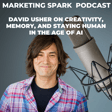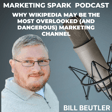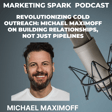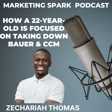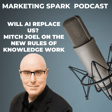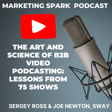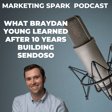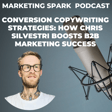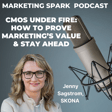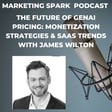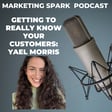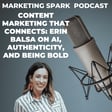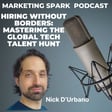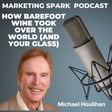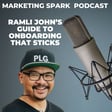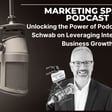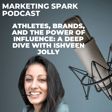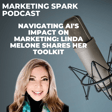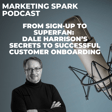Become a Creator today!Start creating today - Share your story with the world!
Start for free
00:00:00
00:00:01

From Developer to Demand Generator: Vahagn Sargsyan on Building the Krisp Brand and Voice AI Category
In this episode of Marketing Spark, Mark Evans sits down with Vahagn Sargsyan, VP of Marketing at Krisp, a pioneering voice AI company.
Vahagn shares his unique journey from full-stack developer to marketing leader and dives into the strategies behind Krisp's emergence as a category-defining brand. He explains how Krisp went from a simple noise-cancellation tool to a comprehensive AI-powered communication platform used by millions, including enterprise clients like call centers and Discord.
This conversation explores agile marketing, product-led growth, community-driven innovation, and how aligning closely with customers can fuel brand loyalty and expansion.
Transcript
Introduction to Bahagen Sarxian's Background
00:00:10
Speaker
Today on Marketing Spark, we're joined by someone who's lived and breathed the full journey. From lines of code to headline marketing campaigns, Bahagen Sarxian is a former full-stack developer turned marketing leader, bringing more than 15 years of hands-on experience across top-tier tech companies.
00:00:27
Speaker
Currently the VP of Marketing at Crisp, one of the leading noise cancellation companies, Bahagen has built his career on one core philosophy, Marketing shouldn't mask product flaws. It should spotlight product excellence.
00:00:40
Speaker
And at Crisp, he didn't just market a feature, he helped invent an entirely new category by listening to real customer experiences and crafting messaging that resonates. In today's conversation, Valhagen will walk us through how Crisp created the noise cancellation space, how he aligns marketing strategies with evolving customer feedback, and how agile marketing tactics can keep startups nimble in the face of rapidly changing markets.
00:01:05
Speaker
Now, whether you're leading a lean marketing team or scaling for enterprise growth, This episode is packed with actionable insights. Vahagin, welcome to the show.
Transition from Developer to Marketing Leader
00:01:14
Speaker
Thank you, Mark. As I said off the top, you've had a very interesting journey to becoming a marketing leader.
00:01:23
Speaker
I started off as a reporter. I joined a startup and became a marketer. And then I evolved into a senior marketing leader. Yours is different. You started as a full stack developer.
00:01:33
Speaker
Walk us through your journey. How did you go from writing code to doing marketing campaigns? Walk us through that path that led you to Crisp. started as a engineer, I was a full stack developer and I was writing codes with PHP, JavaScript, jQuery at the time was a hot topic.
00:01:54
Speaker
And I worked around three years as a full stack developer, but pretty early on, I found myself to round to something entirely different, which was marketing.
00:02:06
Speaker
I think the reason is that I always been fascinated by how people think, how people make decisions. When I discovered that marketing is this perfect intersection of psychology and system thinking, I just fell in love with it.
00:02:19
Speaker
Around 2011, I had this shift in my career from a full stack developer into a marketing specialist, and I started as a SEO specialist. So that was my entry point in marketing. Then I grew towards performance marketing. Then leadership roles and so on.
00:02:37
Speaker
Before joining Chris, worked in a few different companies.
Inspiration from Rocket Internet's Startup Culture
00:02:40
Speaker
One of them was Rocket Internet, which was the first place where I got exposed to the startup world and tech ecosystem and so on.
00:02:50
Speaker
The experience really sparked something in me. I felt the excitement of building products and shaping marketing from the scratch. And I also realized that I truly enjoy working in an early stage environment where nothing in is set up yet. You have to create from the ground up.
00:03:06
Speaker
And yeah, that eventually led me joining Crisp in 2019. I joined as the marketing director. At the time, company was still on early days, no marketing engines, no revenue, no clear product category, but the vision was clear. So I was joining a company that was trying to shape a new product category.
00:03:31
Speaker
We'll talk a little bit about Crisp and how it has established market leadership. I want to ask you about your view on being a developer, understanding how code is written and how that gives you an edge as
Crisp's Evolution and Bahagen's Role
00:03:48
Speaker
a marketer. A lot of marketers, including myself, we're writers or creative types.
00:03:53
Speaker
If I'd gone back in time, I would have learned how to code. As a developer, how does that change your approach to marketing? Does it give you an edge? Does it give you insight that you think other marketers don't have? In my experience, it's been very helpful for me as a marketer because first, being a developer changes your mindset. You start to think more differently.
00:04:15
Speaker
Structured, you try to be more structured when planning, when coming up with new ideas and so on. So that's the part that stays with you your whole life. It's the part that impacts the mindset and how you think and how you manage projects.
00:04:31
Speaker
The other part is how good you understand and perceive products, because if you are working in a tech company as a marketer, you need to have a good enough understanding of how the product works, how the code works, how the features are designed and so on. I think that's where having a development background gives you an edge, right?
00:04:54
Speaker
You start to better understand the product itself and also it improves your communication with the tech teams. So it becomes much easier to communicate with a product manager, with head of engineering and so on. So to me, that's been very helpful.
00:05:11
Speaker
want to talk about your experience at Crisp and what you're doing there. Let's take a step back and have you deliver the Crisp elevator pitch or the value proposition. Great brand.
00:05:22
Speaker
You've been there for, as you said, six years, building the brand from scratch, the marketing engine from scratch. So talk about Crisp, what it does, who it serves, and then we can talk about how the company has leveraged marketing to establish itself as the market leader.
00:05:40
Speaker
k Crisp is a voice AI company with the main goal of improving communications through AI, human to human communications. And we started as a simple noise cancellation feature back in 2018.
00:05:54
Speaker
But now Crisp is a voice AI platform that operates in three different business lines. So we have our AI Meeting Assistant business line, which is a tool that transcribes, summarizes, records the meetings, plus some additional AI features.
00:06:11
Speaker
The second business line is Chris for call centers. So we have special product designed for call centers. It includes lots of features like noise cancellation, accent conversion, which is our latest technology.
00:06:25
Speaker
And there are lots of other products like live interpretation, for example, that's our new product that we have created for call centers. And finally, we have our third business line, which is CRISP as a technology.
00:06:39
Speaker
And in that business line, we have lots of other voice AI companies that use CRISP as part of their product. So they simply integrate CRISP inside their product and get the values that our customers get. So Discord, for example, is one of those clients that we have. If you use Discord, you can see Crispy's working in the background as a noise cancellation tool.
00:07:05
Speaker
From a marketing perspective, I'd be interested in the path from a single application noise cancellation and Chris got a lot of traction. Maybe we can talk about how that happened and what levers you pull to build the Chris brand.
00:07:22
Speaker
And as well, how does marketing evolve and your product portfolio starts to expand and you're dealing with different types of customers with different needs.
00:07:33
Speaker
Pretty juicy, up chunky question. Why don't we start with the original premise of Crisp in noise cancellation and talk about what kind of marketing did you do? How did Crisp become one of the leaders? How did you build that brand so that it had the firepower to expand into other markets?
00:07:55
Speaker
That's a great question. I will start from the times that Crisp was just a noise cancellation tool. And one big problem that we had at the time was that unlike my previous companies where I was operating in already established product categories and markets, at the time that I joined Crisp, no one was searching for a noise cancellation tool.
00:08:19
Speaker
right So it was a new category that we were trying to build with zero demand. So people were not looking for it. It was different from my previous experiences because in my previous companies, we were trying to capture a demand that already existed in the market.
00:08:36
Speaker
But at CRISP, we were trying to build a new category, which is I would say, a fundamentally harder and more expensive type of marketing problem. because you are not just explaining your product. You first have to explain that the problem exists and then you have to explain why it matters. And finally, you have to position your product as a solution for that particular problem.
00:09:03
Speaker
It was a difficult problem to solve. I remember at the time we were trying to basically list our product into websites like G2, Gartner, Trustpilot and the other ones.
00:09:17
Speaker
But it literally didn't have a place to belong. So there were no category as noise cancellation on G2, on Gartner and other platforms. So we started to build that. We worked with G2 in order to define what noise cancellation software even means.
00:09:34
Speaker
Who are the players? What is the problem that we're solving? How is noise cancellation different from other audio tools and so on? So probably that was one of the biggest challenges that we had at the first place.
00:09:47
Speaker
Was that the initial marketing motion to establish the category?
Building Brand Awareness and Gaining Initial Traction
00:09:52
Speaker
not talking about advertising or content marketing or influencer marketing. Did you start with category building and using g two and Capterra and Trustpilot as the foundation for what you would do from a marketing perspective? Because as you said off the top,
00:10:10
Speaker
There was no marketing team. There was no marketing engine. Likely it was you. Why did you make that decision to start with G2 and other platforms?
00:10:23
Speaker
G2 and other platforms were part of the journey, but they were not the starting point. We started with actually launching the product in different platforms like Product Hunt at the time, which brought lots of popularity to Chris because we were recognized as the product of the year back in 2019 on Product Hunt.
00:10:45
Speaker
And then we started to get some traction from tech savvy community because there were lots of gamers, lots of freelancers on Product Hunt.
00:10:56
Speaker
And we started to get some signups, installs. They started to use Crisp. And because it was and new technology at the time, the first early adopters started to basically do the marketing for us.
00:11:12
Speaker
but They were sharing the product on Twitter. They were sharing with their friends. And because of that, we got lots of brand awareness, word of mouth and so on. And as we started to get that early demand, we were thinking about how we should position this product moving forward because there were different type of users. They were gamers, they were freelancers, they were call center agents, and each of each of them had their own kind of perception of the product.
00:11:45
Speaker
So we wanted to have one single category, one single umbrella that we can place all these different use cases. So that was the time that we started to work with industry analysts with G2 and other platforms in order to build that category.
00:12:00
Speaker
One advantage you did have was Crisp was in many ways the right product at the right time. Podcasting was starting to emerge. Obviously you have gamers, you have call centers.
00:12:13
Speaker
And there may not have been a lot of competition, but there was a lot of demand, I suspect. I remember back in the day when I started to use Crisp, eliminate background noise. And at the time I had a dog and I had kids and they would come into my office.
00:12:27
Speaker
And it was almost like this was the most amazing technology because it dealt with the world around me. Was that one of the advantages of it, Chris, that you entered in? Like you just had this built-in demand and people were waiting for a company like yours to step into it. And then you get a little bit of a reality.
00:12:45
Speaker
ah It built upon itself. Is that the initial formula for success? We launched the product in 2019 for the first time and a few months later COVID started. So lots of people were working from home, lots of background noises, pets and so on.
00:13:02
Speaker
And suddenly, CRISP went viral because it was solving a problem. That was a new problem, actually. Probably before that, no one was thinking about background noise being a real problem. But as people started to work from home, noise turned into a real problem. And at the time, we were the only solution in the market that was working with different platforms.
00:13:25
Speaker
Crisp was working with Zoom, was working with Google Meet and so on. And suddenly we had like millions of people looking for a solution, which was one of the reasons that we got this huge brand awareness in 2020. Yeah, I would say being at the right place at the right time was one of the things that really helped Crisp become vital.
00:13:48
Speaker
Once you've got that market momentum, once you've built some brand awareness, which is amazing given many companies, most companies never get brand awareness, and you've got a growing community, how do you leverage
Community Engagement and Product Refinement
00:14:02
Speaker
that? How do you capitalize on the fact that you've got brand presence?
00:14:07
Speaker
It's a lot of easier to use PR, for example, or to do influencer marketing when you've got some momentum. People already know that the brand exists. It's harder when you're building from scratch. So once you built, once you got notoriety through product hunts and you're on Zoom and Google, what other marketing levers did you pull to accelerate marketing and sales?
00:14:31
Speaker
I think the most important thing is to have this connection and sense of community with your users. In our case, our early adopters and users, most of them were decision makers in their companies.
00:14:46
Speaker
They were tech savvy people. They were influencers even. We were trying to keep this close connection with them and help them get the best out of Crisp. And even we were getting ideas from them about the features, about the products. We created this sense of community and that helped us to basically be able to build a product and grow into a product that our users keep using.
00:15:17
Speaker
But at at the time, when we were just a noise cancellation software, where we were thinking about, okay so what should be next? What other features and products we should start building? One of the main inspirations for us was the feedbacks that we were getting from the customers and early adopters.
00:15:35
Speaker
So they will keep asking about new features, new products, and that was the main source for us to get our ideas on what we want to build next.
00:15:46
Speaker
From that perspective, if you are an early stage startup, it's super important to have that close connection and collaboration with your early adopters. want to take a step back and talk about community building because for marketers, community like the Nirvana, if you can build a vibrant,
00:16:03
Speaker
community of users who love your product, evangelize it, provide you with feedback, talk among each other, then it's basically marketing goals because they do a lot the marketing for you.
00:16:15
Speaker
How did you build that community? Was there a formal approach to community building? Were you supporting different external groups? A lot of marketers would be interested in Where do you start with community? How do you build community? How do you take advantage of community to do the marketing that you want to do?
00:16:36
Speaker
I think for us, it was more about having direct connection and direct communication channels with the customers. Because at the early days, Greece was still a very small team.
00:16:50
Speaker
There were just a few people in the marketing. It was me and one of the co-founders that was focused on marketing. And we were answering all the comments, we were replying to all the comments on, let's say, Product Hunt, AppSumo, and all the other platforms.
00:17:07
Speaker
And because of this direct engagement and connection with the users, and since the users also were realizing that, like, we are the decision makers of the company that are in touch with them,
00:17:19
Speaker
they were feeling much more kind of relaxed and easy to share ideas. And I think for the early stage startups, especially for the co-founders, it's very important to be in direct connection with the customers.
00:17:33
Speaker
Because if the customers feel like um feel that their comment, their feedback can be turned into the next feature or next product for the company, they feel much better. And I think From that perspective, our our co-founders did a great job because they were basically the frontline. They were supporting customers, replying to tickets, replying to comments. And I think that was one of the playbooks that we basically adapted.
00:18:00
Speaker
It's an interesting approach to marketing because it's one thing to talk to customers, but customers want to feel like they're being heard. Their ideas, their feedback, their input matters to the company. And the fact that you've got your co-founder and the head of marketing on the front lines and users are aware of that.
00:18:20
Speaker
That's marketing magic because you start to build relationships and as important trust. They recognize that you matter to them and they matter to you. in many ways, develops this virtual circle, which is great.
00:18:35
Speaker
As Crisp gains traction and as you look to expand the product portfolio, what challenges are you facing or did you face from marketing perspective?
Marketing Strategies for Crisp's Business Lines
00:18:47
Speaker
Yes, you can build community for the original product and you get on product hunt and G2 does really great job for you. But what about these new products?
00:18:56
Speaker
Was the marketing different? Were you able to ride the Crisp brand? Walk us through that marketing exercise.
00:19:05
Speaker
Definitely each product and each business requires its case it specific type of marketing. For us, in each of our business lines, we have different approaches.
00:19:17
Speaker
So in our AI meeting assistant business line, which is our consumer product, our motion is more sort of product-led type of acquisition. So we try to build the best possible product and then gain new users, gain new brand awareness through viralities that happens through the product itself.
00:19:39
Speaker
From a playbook perspective, I would say product-led growth is one of the main motions that we currently have, but it's different in other business lines. So for enterprise and call center business,
00:19:51
Speaker
That is our second business line. It's a totally different motion. It's a more sales led marketing assisted type of motion. So you still need to have the marketing team creating the demand, creating the leads.
00:20:06
Speaker
and then sales team working on closing that. So we have these two different type of motions right now. But one thing that basically combines and units these two different approaches is the brand that we have built on top of our businesses, right?
00:20:24
Speaker
So we try to position Crisp as the voice AI platform that uses AI to improve communication. And that resonates with both of these business lines, because for both call centers and also for consumers, that what we offer at the first place, it's an AI that helps you improve communication to become more productive.
00:20:45
Speaker
And that's the main positioning that we have across both business lines.
00:20:52
Speaker
Great to hear how Crisp is handling things from the top down in terms of product-led growth and sales-led growth. What about underneath? When you open up the engine and you've got to connect the two businesses, you've got some consumers that are product-led and some are sales-led and then they blur and the business starts to get more complicated, and more complex because the types of products you're offering, you can buy this and that, you can buy in different ways.
00:21:17
Speaker
What is Chris, done from a revenue stack or a marketing stack perspective to make sure you've got synchronization and that sales and marketing from both types of businesses are working together.
00:21:31
Speaker
One of the best decisions that we've made at CRISP in the past couple of years was to separate how these different business lines operate.
00:21:41
Speaker
So we used to have centralized teams, like centralized marketing team, sales team that were handling the operations for both business lines. But at some point, we realized that even though these two business lines are for crisp are under the same brand, but they require totally different approaches.
00:22:02
Speaker
So we started to create smaller teams that are dedicated to one specific business lines. And that happened ah across all functions. So that started from engineering.
00:22:14
Speaker
We started to have different distinct engineering teams that were focused on just one product. And then that happened across product team, marketing team, sales teams, and so on.
00:22:26
Speaker
So on the leadership layer, we still have the centralized leadership. But when it comes to operational excellence, we have teams that are focused on specific problems and specific business lines.
00:22:40
Speaker
And we try to keep these two business lines separate because we are targeting completely different audiences. They have their specific needs.
00:22:51
Speaker
And that's the reason that we separated that. How do you underpin your business in terms of technology to make sure that you have systems in place that can support product-led growth and sales-led growth?
00:23:06
Speaker
From our product perspective, we still have this big, crisp voice AI platform that is the foundation of the product. But depending on what business line and what customer we are serving, we are able to build and add different sort of functions and add-ons on top of that voice AI platform.
00:23:26
Speaker
So if you are an SMB, you can choose to use Crisp, AI meeting assistant, meeting transcription, and those kinds of tools. And if you are a call center, you can pick AI accent conversion, for example.
00:23:39
Speaker
So from a product perspective, the foundation, the platform is still the same, but we allow users and customers to choose the specific features and products that they want to use.
Balancing Brand Building with Growth Metrics
00:23:51
Speaker
There's a lot of talk these days about brand building. and The pendulum seems to be swinging back to brand from data-driven marketing. The idea that not everything necessarily needs to be quantified. Not everything needs to be measured. There's some things that can be quasi-measured or not measured at all.
00:24:13
Speaker
So it as the VP marketing, how do you balance long-term brand building? And Crisp has a great brand with the, i don't know if it's the right word, urgency of short-term growth metrics. building the brand, but also driving the business from a metrics perspective.
00:24:28
Speaker
I think having that balance is probably one of the most important and difficult jobs of a marketing leader because sometimes you have some immediate goals to hit. It can be revenue, it can be like a number of leads and so on.
00:24:43
Speaker
But at the same time, you need to build this long-term brand that you want to invest in. For that, there are a couple of things that we do at CRISP. One of them is to use clear frameworks and templates. So for the frameworks, we use OKRs for the short-term planning and short-term goals.
00:25:04
Speaker
And for the long-term, we have this company vision, which is about what CRISP should be in the next three to five years. And then it works like a waterfall, right? You have this big vision of the company in the next three to five years.
00:25:21
Speaker
Then we translate that into annual goals, which are in the form of revenue targets, ARR and so on. And then for short-term planning, we break that down into OKRs. So on the top, there's vision, then there's revenue goals, and then we have OKRs for the short-term planning.
00:25:43
Speaker
When it comes to marketing, for the short-term planning, we usually focus on channels that kind of are fast to act and response, like performance marketing, for example, advertisement.
00:25:56
Speaker
Those are the channels that we use for achieving our short-term goals. But for the long-term investments, probably brand building and SEO are the most important channels for us.
00:26:07
Speaker
SEO has been one of the most important channels from the day one. And we always treated that as a long-term investment for the company. Brand is also one of those channels that we always try to build and invest for the long-term without basically looking for short-term gains.
00:26:28
Speaker
Another hot topic these days is ah SEO versus LLMs and the emergence of perplexity and ChatGPT and Claude. From a marketing leader perspective, what's the what's your approach to these models and how does it impact or how has it impacted Crisp is is marketing because as you said, you guys depend a lot on SEO and now there's a question of whether SEO matters or whether it's changed.
Adapting to SEO Changes with AI Tools
00:26:58
Speaker
So interested in how you're approaching this whole new world. Sure. So I think on the surface, a lot has changed. People used to search only on Google, getting some links in order to view, but now they get AI generated answers.
00:27:13
Speaker
Most of the users do not search in Google at all. They start with LLMs and so on. so A lot has changed on the surface, but I think from marketer's perspective, you still need to create high value and high quality content.
00:27:32
Speaker
So that part has not changed. It's still the same. And even now, if you create high quality first-hand content, a content that is really useful for customers and users, you still have a high chance to be listed both on search engines and also to be promoted by LLMs.
00:27:51
Speaker
So from that perspective, what has changed at CRISP is that we started to leverage AI tools, we started to leverage LLMs in order to create more high quality content and first-hand content.
00:28:05
Speaker
But yeah, from users perspective, basically, they used to start with Google at the first place, but now there are lots of different LLMs. But we try to basically, yeah, still continue what we were doing, create high quality content, create something that is firsthand and then distribute that.
00:28:24
Speaker
have any tips for fellow marketers on how to make sure your content is tracked and indexed by the LLMs? Because it's one thing to write content, but you have to make sure that JetGPT picks it up and starts with somebody puts in a prompt about noise cancellation technology, CRISP comes up.
00:28:46
Speaker
Any tips and tricks that you can share? I recently noticed that Google Analytics has added separate section on the referral traffic for LLM. So now we can see how many sessions and traffic you are getting from ChatGPT and other LLMs. So that's something that we try to keep tracking that we always monitor.
00:29:10
Speaker
That's super important. I also learned that other tools such as Ahrefs and other standard SEO tools have added specific features for tracking LLM traffic.
00:29:22
Speaker
But from a leadership and marketing leadership perspective, I think one of the channels and one of the tools that helps us to be listed on LLMs is PR.
00:29:32
Speaker
Because LLMs do not just look at the signals and content that is listed on your website. But they also look at the third party reviews, what other websites are writing about you. And from that perspective, PR has been one of the most important channels that has helped us to have more listings on LLMs.
Leveraging PR with a Strong Narrative
00:29:54
Speaker
At the right time in the right place, PR can be a very good investment. PR can also be very expensive. There's no guarantees of returns no matter how good a PR agency says they are and the things they claim they can do.
00:30:10
Speaker
When is the right time for PR? At what point... Does it make sense for a company to leverage PR? My thesis is that early days probably doesn't make sense because it's expensive and you haven't got a track record. But as a brand like Chris Gaines Momentum, get some brand presence, you can amplify your story using PR. Does that make sense to you? Is that a a reasonable approach to PR?
00:30:35
Speaker
For the early days, you just need to focus on building those inbound muscles like SEO, for example, because you need to have a strong and a compelling story to tell in order to have a PR campaign.
00:30:50
Speaker
And that usually doesn't happen in the early stages of the startups. You need to have a user base. You need to have this interaction with the users in order to be able to craft compelling stories.
00:31:03
Speaker
On that front, I fully agree. It's it's not a channel for early stage startups. but I think maybe after a couple of years when you have the money and you also have the stories to tell the world, the stories that are coming from users, are coming from the feedbacks that you receive, are coming from the case studies that you have built with the customers, that's the right time to start testing PR as a channel.
00:31:29
Speaker
I would say the right time for doing PR is when you have a strong point of view or interesting story or strategic narrative to communicate to the world. That's the right time to start.
00:31:45
Speaker
We've covered a lot of grounds, everything from AI to PR to SEO and brand building. want to thank you for your insight. One final question.
Where to Learn More About Crisp and Bahagen
00:31:54
Speaker
If people are interested in you and Crisp, where do they go? What do they do?
00:32:01
Speaker
Type in Crisp.ai, crisp.ai. You can land on our website. You can see the products that we have. And I'm also always available and active on LinkedIn, so we can get in touch there.
00:32:12
Speaker
Awesome. Thanks, Val Hagen, for your insight and thanks to everyone for listening. If you found this episode valuable, leave a review or share it with a colleague, especially someone wrestling with the same marketing challenges and opportunities as Crisp.
00:32:25
Speaker
Marketing Spark is all about helping B2B SaaS founders, marketing leaders, and entrepreneurs uncover what's working, what's changing, and what's next in the world of growth. If you're B2B SaaS marketer or founder with a unique story or a fresh take on marketing, growth, or leadership,
00:32:40
Speaker
I'd love to hear from you. Reach out to me on LinkedIn and let's talk about getting you on the show. Until next time, thanks again for listening to Marketing Spark.
